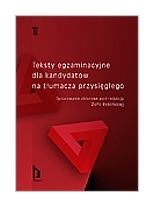Podstawowy podręcznik dla tłumaczy prawniczych języka angielskiego i
prawników, niezbędny dla adeptów zawodu tłumacza przysięgłego, wprowadzający w
specyfikę struktury gramatycznej angielskiego języka prawa, systematycznie opisujący
charakterystyczne zjawiska językowe i przekładowe ilustrowane przykładami z różnych
krajów anglojęzycznych
Spis treści:
Acknowledgements
Preface
I. INTRODUCTION
II. LEXICAL FEATURES OF LEGAL ENGLISHVOCABULARY
1. Loanwords
2. Derivation
3. Latin fixed expressions
4. Compounding
5. Clipping
6. Contracted verb forms
7. Blending
8. Conversion
9. Backformation
10. Collocations
11. Nouns ending in ęr/-or and -ee
12. Abbreviations
13. Acronyms
III. GRAMMAR
IV. MORPHOLOGY
V. WORD CLASSES
(a) Introductory notes on word classes in legal English
(b) Details of the major word classes in legal English
1. Nouns
1.1. Common and proper nouns
1.2. Count and non-count nouns
1.3. Number
1.4. Saxon genitive
1.5. Gender
1.6. Definiteness
1.7. Zero determiner
2. Pronouns
2.1. Personal pronouns
2.2. Special uses of pronouns
2.3. Orientation within the text
2.3.1. Same/former/latter
2.3.2. The foregoing/the above/aforesaid
2.3.3. One/-ever
2.3.4. Some-/any-
2.3.5. Other/another
2.4. Demonstrative pronouns
2.5. Relative pronouns
2.6. Universal pronouns
2.7. Quantifiers
2.8. Other pro-forms
2.8.1. Here-/there-/where-
3. Adjectives
4. Adverbs
5. Verbs
5.1. Archaic forms
5.2. Phrasal verbs
5.3. Verbs of Germanic origin
5.4. Analytical verb forms
5.5. Emphatic do
5.6. Pro-form do
5.7. Negative do
5.8. Transitive and intransitive verbs
6. Tense
7. Aspect
7.1. Simple
7.2. Progressive
7.3. Perfect
8. Mood
9. Subjunctive
9.1. Negative BE subjunctive
9.2. Subordinate conditional clauses
9.3. Concessive clauses
9.4. Unreal comparison
9.5. Hypothetical choice
10. Modal verbs
10.1. Deontic and epistemic modality
10.2. Shall
10.2.1. Shall in temporal clauses
10.2.2. Shall in conditional clauses
10.3. Should
10.4. May
10.5. Will/would
10.6. Can/could
10.7. Must
10.8. May and shall coordinated
11. Causatives
12. Passive voice
13. Non-finite verb forms
13.1. Infinitive forms
13.2. Split infinitive
13.3. -ing forms
13.4. -edforms
14. Prepositions
14.1. Characteristic uses of selected prepositions ,
15. Conjunctions
15.1. Characteristic uses of selected conjunctions
VI. SYNTAX
1. Syntactic structures
VII. CLAUSE ELEMENTS
1. Subject and predicator
1.1. Negative subjects
2. Object
3. Complement
4. Adverbial
5. Apposition
VIII. TYPES OF SENTENCES
1. Word order (order of clause elements)
2. Coordination
2.1. Nominal
2.2. Verbal
2.2.1. Finite verb forms
2.2.2. Infinitives
2.2.3. -edparticiples
2.2.4. -ing forms
2.2.5. Modal verbs
2.2.6. Chains of verbs
2.2.7. Causatives coordinated with non-causatives
2.3. Adjectival
2.4. Adverbial
2.5. Pronominal
2.6. Prepositional
2.7. Other
3. Coordination of converses
4. Coordination of opposi‘es
5. Coordination of items followed by different prepositions
6. Coordination of various grammatical forms of the same
item
6.1. Singular and plural forms
6.2. Active and passive
6.3. Two or more tenses
6.4. Non-causative and causative forms
6.5. Forms with and without a modal verb
7. Split coordination
8. Generalization
9. Extension
10. Coordinate clauses
11. Subordinate clauses
11.1. Conditional clauses
11.2. Alternative concessive conditional clauses
11.3. Temporal clauses
11.4. Comparative clauses
11.5. Clauses of purpose
11.6. The fact that
12. Non-finite clauses
12.1. Infinitive clauses
12.2. -ing form clauses
12.3. -ed participle clauses
13. Verbless clauses
14. Construction there is
15. Some special features involving negation
16. Inversion
IX. APPENDIX
1. Other typical features of legal English
1.1. Use of Latin and French words
1.2. Alliterated phrases
1.3. Quotidian terms
1.4. Terms of art
1.5. Punctuation
1.6. Cross-reference markers
1.7. Long sentences
1.8. Nominalization
2. False friends in legal English
3. Notes on pronunciation
3.1. Pronunciation of legal Latin
X. EXERCISES
Bibliography
248 stron, oprawa twarda
Księgarnia nie działa. Nie odpowiadamy na pytania i nie realizujemy zamówien. Do odwolania !.



 -
-